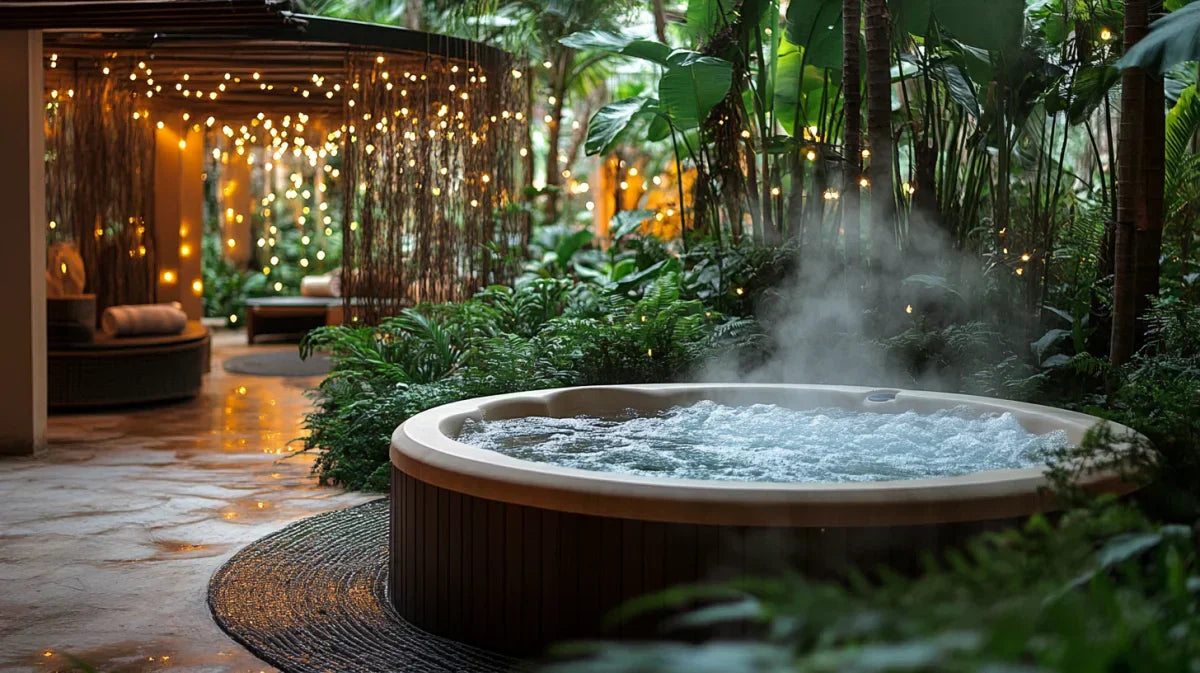Congratulations on becoming a new inflatable hot tub owner! An inflatable hot tub, also known as a portable spa, is an affordable and convenient way to enjoy the relaxing benefits of hydrotherapy massage jets, soothing hot water, and spending quality time with friends and family. As a first timer, there are some key tips to get the most out of your inflatable hot tub experience right from setup through your first soak and beyond. Follow this beginner’s guide to hot tubbing bliss!
Choosing the Ideal Location
One of the great advantages of an inflatable hot tub is that it can be set up quickly both indoors and outdoors. When selecting the perfect spot, consider the following:
-
Access to Power - Ensure there is an outdoor electrical outlet or indoor power supply within reach to safely operate the hot tub. Use a ground fault circuit interrupter (GFCI) for protection. Extensions cords are not recommended.
-
Flat, Stable Surface - Set up the inflatable hot tub on a level patio, deck, or grass area with no bumps or dips. Avoid soft or loose soil. A hot tub pad provides optimal support and insulation.
-
Drainage - Pick a location where you can safely drain and dispose of water easily after use. Avoid areas where drainage could impact foundations or seepage could occur.
-
Privacy - Consider privacy from neighbours and wind barriers that may impact jets and heating. Fencing, landscaping, and partial-wall placements can help.
-
Convenience - Pick a spot near your home's back door for quick and easy access, and on the level ground floor if loading the hot tub upstairs. Ensure wheelbarrow or dolly access.
Take measurements of your chosen spot and compare to the inflated size of your hot tub model to ensure a proper fit with safe access space around the sides to pass by.

Initial Hot Tub Setup
With an ideal outdoor or indoor location selected, here are the key steps for proper initial hot tub setup:
-
Clear Debris - Carefully clear any sticks, acorns, pine cones, stones, or sharp objects from the area where you'll place the hot tub to prevent possible punctures or tears.
-
Inflate the Hot Tub - Following the user manual, inflate the spa walls slowly and carefully. Ensure it is evenly inflated all around, and slightly firm to the touch. Do not over inflate. Check for any leaks.
-
Fill with Water - Use a hose water supply or buckets to fill the tub to the correct water level. Do not overfill past the maximum indicated on the inside walls. Not enough water could damage the pumps.
-
Install Insulation - For maximum heat retention, install a hot tub insulation jacket and lid before heating. This will save a significant amount of energy and cost.
-
Connect & Test - Connect the control panel and pump system, and test all of the jets and functions to make sure everything is working properly before adding chemicals or bathers.
-
Heat & Treat Water - Turn on the heater and jet functions. Add hot tub chemicals and sanitiser as directed while the tub warms to the desired temperature (38-40°C is ideal).
Allow at least 20-24 hours for the water to properly filter, heat, and circulate before your first use. Check and adjust as needed to balance chemicals and reach set temperature.
Maintaining Proper Water Chemistry
Clear, clean, balanced water is essential for a safe, relaxing hot tub experience while also protecting your inflatable spa equipment from damage. Follow these hot tub water chemistry basics:
-
pH Balance - Test pH daily and adjust to maintain a range of 7.2 to 7.6. Add pH increaser or decreaser as needed.
-
Sanitiser Level - Maintain the appropriate sanitiser level, typically 2-5 ppm chlorine or 3-5 ppm bromine. Shock treat as needed.
-
Total Alkalinity - Keep total alkalinity between 80 and 150 ppm to avoid pH fluctuations and corrosion.
-
Calcium Hardness - Ideal calcium hardness is 150-250 ppm to prevent scale buildup or water foaming issues.
-
Regular Testing - Test and record hot tub water chemistry at least 2-3 times per week using quality test strips.
-
Water Changes - Drain and refill your hot tub with fresh water every 3-4 months as needed. Clean the filters monthly or more often.
Monitoring your water chemistry helps provide a hygienic, therapeutic hot tub experience while saving you money by preventing costly maintenance issues.
Energy Efficiency and Heating Costs
As a new owner, you will quickly realise that water heating is the main cost and energy draw of maintaining your inflatable hot tub. Keep these savings tips in mind:
- Turn down the thermostat to 38-39 °C when not in use
- Invest in a well-fitting hot tub cover and insulation jacket
- Insulate the pump machinery
- Avoid excessive jet use when heating
- Set filtration cycles to run at night when rates are lower
- Limit major heat loss from wind, shade cover helps
The proper use of insulation and maintaining balanced water chemistry will make the biggest impact on optimising your inflatable hot tub's efficiency.
Health, Safety, and Etiquette Reminders
As exciting as your first dip may be, please keep these usage tips in mind:
- No glassware or alcohol in or near the hot tub
- Shower before and after use
- Keep hair tied up and remove jewellery
- Limit soak time to 10-15 minutes, take breaks
- Watch children closely, enforce safety rules
- Enter and exit slowly, prevent slips
- Respect noise limits for late night use
- Rinse swimsuits after, wash covers occasionally
Following safe hot tubbing practices ensures a fun experience for you, your family, and guests. Be sure to also review the detailed owner's manual for your specific model.
Troubleshooting Common Problems
Despite best preparations, you may encounter a few hiccups as a new inflatable hot tub owner. Try these fixes for frequent problems:
Water Not Heating
- Ensure insulation is installed correctly with no gaps
- Check error codes and electrical connections
- Clean/replace filter cartridges if restricted
- Give newly treated water 24 hours to heat
Cloudy Water
- Test and adjust chemistry, shock treat and filter
- Ensure proper filtration time daily
- Clean or replace filters if needed
Pump Not Working
- Check GFCI connections, reset breaker
- Ensure valves are open, jets turned on
- Test by resetting system, prime pump if needed
Leaks
- Turn off power, drain to appropriate level
- Locate leaks at seams or fittings
- Apply adhesive patch on inside to seal
- Contact manufacturer if major structural issues
Flashing LCD Panel
- Hold the power button on the panel to force reboot
- Check for clogged intakes or pumps
- Contact manufacturer for timer or readout errors
Periodically sanitising your filters, testing water chemistry, replacing jets, and tightening fittings can prevent many common problems and keep your inflatable hot tub running smoothly.
Accessories and Enhancements
As you get more experienced with hot tub ownership, consider accessorising for added enjoyment:
-
Headrests - Pillowed headrests provide neck support during relaxation.
-
Cup Holders - Keep drinks nearby and prevent spills with mounted cup holders.
-
Steps - Sturdy hot tub steps allow safer entry and exit.
-
Shelter - A gazebo, pergola, or awning creates shade and shelters your hot tub.
-
Lighting - LED lighting around the hot tub sets a mood and allows night time use.
-
Entertainment - Waterproof speakers and TVs can be incorporated for entertainment.
-
Cleaning Tools - Specialised hot tub vacuum kits make maintenance easier.
-
Sanitation - Ozonators and mineral purification systems reduce chemical usage.
-
Covers - Upgrading to a high quality cover improves insulation and safety.
No matter which accessories you choose, always ensure they are designed for hot tub use and installed properly.
Enjoy This Therapeutic Oasis
As you look forward to that first relaxing soak, keep these tips in mind for a smooth entrance into inflatable hot tub ownership. Proper setup, water care, insulation, and safe usage will quickly make your hot tub an at-home oasis. Be sure to browse our blog and FAQs for more helpful guidance. With your new inflatable spa, the warm water therapy and peaceful vibes are only a dip away. Congratulations and happy hot tubbing!



